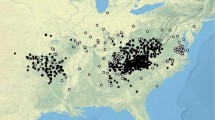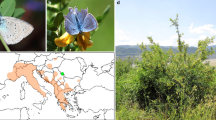Abstract
We argue that insect species conservation at large scales should take account of the distribution of genetic diversity among populations. Maintenance of genetic diversity may be vital in retaining a species' adaptive capacity and evolutionary potential. We illustrate the concept using the example of the large copper butterfly Lycaena dispar in Europe. This species has become extinct in parts of its range and is declining rapidly in others, whilst conversely, increasing in many areas. The latter has recently reduced its conservation status. Mitochondrial DNA analysis is used to construct a phylogeography from a preliminary sample set obtained from across Europe. A cytochrome b fragment of 402 base pairs was sequenced and 10 haplotypes were found. Relatedness among populations suggest that those from northern and central Europe are closely related and probably form one evolutionary significant unit (ESU) reflecting post-glacial colonization from southeast Europe. In contrast, the sample from Italy is divergent and should be considered a separate ESU. Our results, combined with ecological data, suggest that conservation action for this species should be targeted on specific regions and populations.
Similar content being viewed by others
References
Aagaard K., Hindar K., Pullin A.S., James C.H., Hammarstedt O., Balstad T. and Hanssen O. 2002. Phylogenetic relationships in brown argus butterflies (Lepidoptera: Lycaenidae: Aricia) from north-western Europe. Biol. J. Linn. Soc. 75: 27-37.
Asher J., Warren M., Fox R., Harding P., Jeffcoate G. and Jeffcoate S. 2001. The Millennium Atlas of Butterflies in Britain and Ireland. Oxford University Press, Oxford.
Avise J.C. 2000. Phylogeography: The History and Information of Species. Harvard University Press, Cambridge, MA.
Avise J.C. 1994. Molecular Markers, Natural History and Evolution. Chapman and Hall, New York.
Bretherton R.F. 1966. A distribution list of the butterflies (Rhopalocera) of western and southern Europe. Trans. Soc. Br. Entomol. 17(1): 1-94.
Burke A.S. 2002. Life history variation and genetic structure in populations of the butterfly Aricia agestis. PhD thesis, The University of Birmingham, UK.
De Bruijn M.H.L. 1983. Drosophila melanogaster mitochondrial DNA, a novel gene organisation and genetic code. Nature 304: 234-241.
Emmet A.M. and Heath J. 1989. The Moths and Butterflies of Great Britain and Ireland. vol. 7, Part (I). Harley, UK.
Excoffier L. 1993. MINSPNET, http://anthropologie.unige.ch/LGB/softare/win/min-span-net/
Gugerli F., Sperisen C., Büchler U., Magni F., Geburek T., Jeandroz S. and Senn J. 2001. Haplotype variation in a mitochondrial tandem repeat of Norway spruce (Picea abies) populations suggests a serious founder effect during postglacial re-colonization of the western Alps. Mol. Ecol. 10: 1255-1263.
Hewitt G.M. 1996. Some genetic consequences of ice ages, and their role in divergence and speciation. Biol. J. Linn. Soci. 58: 247-276.
Hewitt G.M. 1999. Post-glacial re-colonization of European biota. Biol. J. Linn. Soc. 68: 87-112.
Jaarola M., Tegelström H. and Fredga K. 1999. Colonization history in Fennoscandian rodents. Biol. J. Linn. Soc. 68: 113-127.
Joyce D.A. 2001. The Use of Molecular Genetics in the Formulation of Conservation Strategies for Lepidoptera. PhD thesis, The University of Birmingham, UK.
Joyce D.A. and Pullin A.S. 2001. Phylogeography of the Marsh Fritillary Euphydryas aurinnia (Lepidoptera: Nymphalidae) in the UK. Biol. J. Linn. Soc. 72: 129-141.
Kimura M. 1980. A simple method for estimating evolutionary rate of base substitution through comparative studies of nucleotide sequences. J. Mol. Evol. 16: 111-120.
Knowles L.L. 2001. Did the Pleistocene glaciations promote divergence? Test of explicit refugial models in montane grasshoppers. Mol. Ecol. 10: 691-701.
Kumar S., Tamura K. and Nei M. 2001. MEGA: Molecular Evolutionary Genetics Analysis version 2.0. Institute of Molecular Evolutionary Genetics, The Pennsylvania State University, Pennsylvania, USA.
McCarthy C. 1998. Chromas version 1.45. School of Health Science, Griffith University, Queensland, Australia.
Moritz C. 1994. Defining evolutionarily significant units for conservation. Trends Ecol. Evol. 9: 373-375.
Moritz C. 1995. Uses of molecular phylogenies for conservation. Philos. Trans. R. Soc. Lond. B349: 113-118.
Nesbø C.L., FossheimT., Vollestad L.A. and Jakobsen K.S. 1999. Genetic divergence and phylogeographic relationships among European perch (Perca fluviatilis) populations reflect glacial refugia and post-glacial colonization. Mol. Ecol. 8: 1387-1404.
Nordal I. and Jonsell B. 1998. A phylogeographic analysis of Viola rupestris: three post-glacial immigration routes into the Nordic area? Bot. J. Linn. Soc. 128: 105-122.
Pirounakis K., Koulianos S. and Schmid-Hempel P. 1998. Genetic variation among European populations of Bombus pascuorum (Hymenoptera: Apidae) from mitochondrial DNA sequence data. Euro. J. Entomol. 95: 27-33.
Pullin A.S., Bálint Z., Balletto E., Buszko J., Courtsis J.G., Goffart P., Kulfan M., Lhonoré J.E., Settele J. and van der Made G. 1998. The status, ecology and conservation of Lycaena dispar (Lycaenidae: Lycaenini) in Europe. Nota Lepidopterologica 21(2): 94-100; 10. VII.
Pullin A.S., McLean I.F.G. and Webb M.R. 1995. Ecology and conservation of Lycaena dispar: British and Europe perspectives. In: Pullin A.S. (ed.), Ecology and Conservation of Butterflies, Chapman and Hall, London, pp. 150-164.
Ryder O.A. 1986. Species conservation and dilemma of subspecies. Trends Ecol. Evol. 1: 9-10.
Santucci F., Emerson B.C. and Hewitt G.M. 1998. Mitochondrial DNA phylogeography of European hedgehogs. Mol. Ecol. 7: 1163-1172.
Simon C., Frati F., Bechenback A., Crespi B., Liu H. and Flook P. 1994. Evolution, weighting, and phylogenetic utility of Mitochondrial gene sequences and a compilation of conserved polymerase chain reaction primer. Ann. Entomol. Soc. Amer. 87(6): 651-701.
Sinclair W.T., Morman J.D. and Ennos R.A. 1999. The postglacial history of Scots pine (Pinus sylvestris L.) in western Europe: evidence from mitochondrial DNA variation. Mol. Ecol. 8: 83-88.
Stauffer C., Lakatos F. and Hewitt G.M. 1999. Phylogeography and postglacial colonization routes of Ips typographus L. (Coleoptera, Scolytidae). Mol. Ecol. 8: 763-773.
van Swaay C.A.M. and Warren M.S. 1999. Red Data Book of European Butterflies (Rhopalocera). Council of Europe, Strasbourg.
Taberlet P., Fumagalli L., Wust-Saucy A.-G. 1998. Comparative phylogeography and postglacial colonization routes in Europe. Mol. Ecol. 7: 453-464.
Tolman T. and Lewington R. 1997. Butterflies of Britain & Europe. Harper-Collins, London.
Turgeon J. and Bernatchez L. 2001. Mitochondrial DNA phylogeography of lake cisco (Coregonus artedi): evidence supporting extensive secondary contacts between two glacial races. Mol. Ecol. 10: 987-1001.
Vogel J.C., Rumsey F.J., Schneller J.J., Barrett J.A. and Gibby M. 1999. Where are the glacial refugia in Europe? Evidence from pteridophytes. Biol. J. Linn. Soc. 66: 23-37.
Walsh P.S., Metzger D.A. and Higuchi R. 1991. Chelex-100 as a medium for simple extraction of DNA for PCR-based typing from forensic material. Biotechique 10: 506-513.
Author information
Authors and Affiliations
Corresponding author
Rights and permissions
About this article
Cite this article
Lai, BC.G., Pullin, A.S. Phylogeography, genetic diversity and conservation of the large copper butterfly Lycaena dispar in Europe. Journal of Insect Conservation 8, 27–36 (2004). https://doi.org/10.1023/B:JICO.0000027478.35309.46
Issue Date:
DOI: https://doi.org/10.1023/B:JICO.0000027478.35309.46




